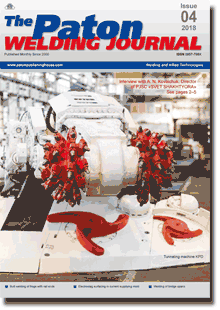| 2018 №04 (08) |
DOI of Article 10.15407/tpwj2018.04.01 |
2018 №04 (02) |

The Paton Welding Journal, 2018, #4, 6-10 pages
Stressed state of welded and brazed assemblies from similar materials with a soft interlayer under axial loading
V.V. Kvasnytskyi1, V.F. Kvasnytskyi2, Dong Chunlin3, M.V. Matvienko2 and G.V. Yermolayev2
1NTUU «Igor Sikorskii Kyiv Polytechnic Institute» 37 Pobedy Prosp., 03056, Kyiv, Ukraine. E-mail: kvas69@ukr.net
2Admiral Makarov National University of Shipbuilding 9 Heroiv Ukrainy Prosp., 54025, Mykolaiv, Ukraine. E-mail: welding @nuos.edu.ua
3China-Ukraine E.O. Paton Institute of Welding Guangzhou, P.R.China. E-mail: dchunlin@163.com
Abstract
Computer modeling method was used to study the stressed state in assemblies, manufactured by diffusion welding and brazing, under the impact of axial load. Cylindrical assemblies from steel with a copper interlayer are considered under loading above the copper yield point. It is shown that formation of a complex stressed state resulted in the level of equivalent stresses decreasing in the interlayer compared to the applied axial load, and increasing in a small zone of base metal near the outer surface at the butt joint with the interlayer that causes the effect of hardening (unloading) of the interlayer and softening (overloading) of base metal. Quantitative dependencies of the degree of interlayer hardening and base metal softening on more load magnitude were derived. It is found that at the elastoplastic stage of assembly loading base metal softening is external pronounced, than at the elastic stage. Degree of interlayer hardening at the elastic stage of its work does not depend on the magnitude of external load, and at the elastoplastic stage it is increased in proportion to the load. 9 Ref., 5 Figures.
Keywords: welded and brazed assemblies, soft interlayer, computer modeling, stressed state, force loading
Received: 12.02.18
Published: 11.04.18
References
- Bakshi, O.A., Shron, R.Z. (1962) Strength at static tension of welded joints with soft interlayer. Proizvodstvo, 5, 6–10 [in Russian].
- Bakshi, O.A., Kachanov, L.M. (1965) On stress state of plastic interlayer at axisymmetric deformation. AN SSSR. Mekhanika, 2, 134–137 [in Russian].
- Bakshi, O.A., Shron, R.Z. (1971) On calculated evaluation of strength of welded joints with soft interlayer. Proizvodstvo, 3, 3–5 [in Russian].
- Makhnenko, V.I., Kvasnytskyi, V.V., Yermolayev, G.V. (2009) Stress-strain state in diffusion welding of materials with different physico-mechanical properties. In: Proc. of 4th Int. Conf. on Mathematical Modeling and Information Technologies in Welding and Related Processes (27–30 May 2008, Katsiveli, Ukraine). Ed. by V.I. Makhnenko. Kiev, PWI, 95–102.
- Makhnenko, V.I., Kvasnytskyi,V.V. (2009) Peculiarities of formation of stress-strain state in diffusion bonds between dissimilar materials. The Paton Welding J., 8, 7–11.
- Kolesar, I.A., Yermolayev, G.V. (2014) Stress-strain state at force and temperature loading of assemblies from dissimilar steels with soft interlayer. , 8, 21–25.
- Yermolayev, G.V., Martynenko, V.A., Olekseenko, S.V. et al. (2017) Effect of the rigid interlayer thickness on the stress-strain of metal-graphite assemblies under thermal loading. Strength of Materials, 49(3), 422–428. https://doi.org/10.1007/s11223-017-9882-4
- Kopelman, L.A. (2010) Fundamentals of strength theory of welded structures: Manual. 2nd Ed. St.-Petersburg, Lan [in Russian].
- Yermolayev, G.V., Kvasnytskyi, V.V., Kvasnytskyi, V.F. et al. (2015) Brazing of materials. Ed. by V.F. Khorunov et al. Mykolayiv, NUK [in Ukrainian].
